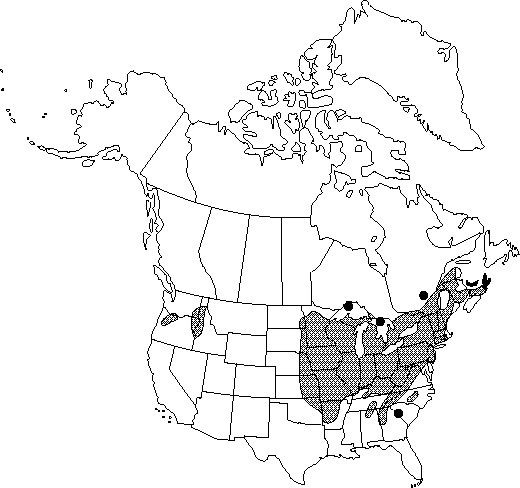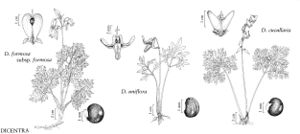FNA>Volume Importer |
FNA>Volume Importer |
| Line 36: |
Line 36: |
| | }}<!-- | | }}<!-- |
| | | | |
| − | --><span class="statement" id="st-d0_s0" data-properties="plant duration;plant architecture;rootstock height or length or size;bulblet coloration;bulblet coloration;bulblet coloration;bulblet shape"><b>Plants </b>perennial, scapose, from short rootstocks bearing pink to white, teardrop-shaped bulblets.</span> <span class="statement" id="st-d0_s1" data-properties="leaf atypical length;leaf atypical length;leaf length;leaf atypical width;leaf atypical width;leaf width"><b>Leaves </b>(10-) 14-16 (-36) × (4-) 6-14 (-18) cm;</span> <span class="statement" id="st-d0_s2" data-properties="petiole atypical some measurement;petiole atypical some measurement;petiole some measurement">petiole (5-) 8-16 (-24) cm;</span> <span class="statement" id="st-d0_s3" data-properties="order quantity">blade with 4 orders of leaflets and lobes;</span> <span class="statement" id="st-d0_s4" data-properties="abaxial surface pubescence">abaxial surface glaucous;</span> <span class="statement" id="st-d0_s5" data-properties="ultimate lobe arrangement or course or shape;ultimate lobe shape;ultimate lobe shape;ultimate lobe atypical length;ultimate lobe atypical length;ultimate lobe length;ultimate lobe atypical width;ultimate lobe atypical width;ultimate lobe width;ultimate lobe architecture or shape">ultimate lobes linear to linear-elliptic or linear-obovate, (2-) 5-15 (-23) × (0.4-) 2-3 (-4.2) mm, usually minutely apiculate.</span> <span class="statement" id="st-d0_s6" data-properties="inflorescence arrangement;inflorescence architecture"><b>Inflorescences </b>racemose, 3-14-flowered, usually exceeding leaves;</span> <span class="statement" id="st-d0_s7" data-properties="beak size">bracts minute.</span> <span class="statement" id="st-d0_s8" data-properties="flower orientation"><b>Flowers </b>pendent;</span> <span class="statement" id="st-d0_s9" data-properties="pedicel atypical some measurement;pedicel atypical some measurement;pedicel some measurement">pedicels (2-) 4-7 (-12) mm;</span> <span class="statement" id="st-d0_s10" data-properties="sepal shape;sepal length;sepal width">sepals broadly ovate, 1.8-5 × 1.3-4 mm;</span> <span class="statement" id="st-d0_s11" data-properties="petal coloration;petal coloration;apex coloration;apex coloration;apex coloration">petals white, frequently suffused pink, apex yellow to orange-yellow;</span> <span class="statement" id="st-d0_s12" data-properties="outer petal atypical length;outer petal atypical length;outer petal length;outer petal atypical width;outer petal atypical width;outer petal width;portion orientation;portion some measurement">outer petals (10-) 12-16 (-20) × (3-) 6-10 (-13) mm, reflexed portion 2-5 mm;</span> <span class="statement" id="st-d0_s13" data-properties="inner petal atypical some measurement;inner petal atypical some measurement;inner petal some measurement;blade some measurement;claw arrangement or course or shape;claw quantity;crest prominence;crest diameter">inner petals (7.5-) 9-12 (-14) mm, blade 1.8-4 mm, claw linear, 4-8 × less than 1 mm, crest prominent, ca. 2 mm diam.;</span> <span class="statement" id="st-d0_s14" data-properties="bundle filament fusion">filaments of each bundle connate from base to shortly below anthers;</span> <span class="statement" id="st-d0_s15" data-properties="nectariferous tissue orientation;spur atypical some measurement;spur some measurement">nectariferous tissue forming 1-3 (-4.5) mm spur diverging at angle from base of bundle;</span> <span class="statement" id="st-d0_s16" data-properties="style some measurement">style 2-4 mm;</span> <span class="statement" id="st-d0_s17" data-properties="stigma shape;lateral papilla quantity">stigma 2-horned with 2 lateral papillae.</span> <span class="statement" id="st-d0_s18" data-properties="capsule shape;capsule shape;end atypical length;end atypical length;end length;end width"><b>Capsules </b>ovoid, attenuate at both ends, (7-) 9-13 (-16) × 3-5 mm.</span> <span class="statement" id="st-d0_s19" data-properties="seed shape;seed diameter;seed architecture or coloration or relief"><b>Seeds </b>reniform, ca. 2 mm diam., very obscurely reticulate, elaiosome present.</span> <span class="statement" id="st-d0_s20" data-properties="elaiosome presence;2n chromosome quantity">2n = 32.</span><!-- | + | --><span class="statement" id="st-undefined" data-properties=""><b>Plants </b>perennial, scapose, from short rootstocks bearing pink to white, teardrop-shaped bulblets. <b>Leaves</b> (10-)14-16(-36) × (4-)6-14(-18) cm; petiole (5-)8-16(-24) cm; blade with 4 orders of leaflets and lobes; abaxial surface glaucous; ultimate lobes linear to linear-elliptic or linear-obovate, (2-)5-15(-23) × (0.4-)2-3(-4.2) mm, usually minutely apiculate. <b>Inflorescences</b> racemose, 3-14-flowered, usually exceeding leaves; bracts minute. <b>Flowers</b> pendent; pedicels (2-)4-7(-12) mm; sepals broadly ovate, 1.8-5 × 1.3-4 mm; petals white, frequently suffused pink, apex yellow to orange-yellow; outer petals (10-)12-16(-20) × (3-)6-10(-13) mm, reflexed portion 2-5 mm; inner petals (7.5-)9-12(-14) mm, blade 1.8-4 mm, claw linear, 4-8 × less than 1 mm, crest prominent, ca. 2 mm diam.; filaments of each bundle connate from base to shortly below anthers; nectariferous tissue forming 1-3(-4.5) mm spur diverging at angle from base of bundle; style 2-4 mm; stigma 2-horned with 2 lateral papillae. <b>Capsules</b> ovoid, attenuate at both ends, (7-)9-13(-16) × 3-5 mm. <b>Seeds</b> reniform, ca. 2 mm diam., very obscurely reticulate, elaiosome present. <b>2n</b> = 32.</span><!-- |
| | | | |
| | -->{{Treatment/Body | | -->{{Treatment/Body |
| Line 71: |
Line 71: |
| | |publication year=1833 | | |publication year=1833 |
| | |special status=Endemic;Selected by author to be illustrated | | |special status=Endemic;Selected by author to be illustrated |
| − | |source xml=https://jpend@bitbucket.org/aafc-mbb/fna-fine-grained-xml.git/src/287ef3db526bd807d435a3c7423ef2df1e951227/V3/V3_230.xml | + | |source xml=https://jpend@bitbucket.org/aafc-mbb/fna-data-curation.git/src/9216fc802291cd3df363fd52122300479582ede7/coarse_grained_fna_xml/V3/V3_230.xml |
| | |genus=Dicentra | | |genus=Dicentra |
| | |species=Dicentra cucullaria | | |species=Dicentra cucullaria |
| − | |2n chromosome quantity=32
| |
| − | |abaxial surface pubescence=glaucous
| |
| − | |apex coloration=yellow;orange-yellow
| |
| − | |beak size=minute
| |
| − | |blade some measurement=1.8mm;4mm
| |
| − | |bulblet coloration=pink;white
| |
| − | |bulblet shape=teardrop--shaped
| |
| − | |bundle filament fusion=connate
| |
| − | |capsule shape=attenuate;ovoid
| |
| − | |claw arrangement or course or shape=linear
| |
| − | |claw quantity=4;8
| |
| − | |crest diameter=2
| |
| − | |crest prominence=prominent
| |
| − | |elaiosome presence=absent
| |
| − | |end atypical length=13mm;16mm
| |
| − | |end length=9mm;13mm
| |
| − | |end width=3mm;5mm
| |
| − | |flower orientation=pendent
| |
| − | |inflorescence architecture=3-14-flowered
| |
| − | |inflorescence arrangement=racemose
| |
| − | |inner petal atypical some measurement=12mm;14mm
| |
| − | |inner petal some measurement=9mm;12mm
| |
| − | |lateral papilla quantity=2
| |
| − | |leaf atypical length=16cm;36cm
| |
| − | |leaf atypical width=14cm;18cm
| |
| − | |leaf length=14cm;16cm
| |
| − | |leaf width=6cm;14cm
| |
| − | |nectariferous tissue orientation=diverging
| |
| − | |order quantity=4
| |
| − | |outer petal atypical length=16mm;20mm
| |
| − | |outer petal atypical width=10mm;13mm
| |
| − | |outer petal length=12mm;16mm
| |
| − | |outer petal width=6mm;10mm
| |
| − | |pedicel atypical some measurement=7mm;12mm
| |
| − | |pedicel some measurement=4mm;7mm
| |
| − | |petal coloration=suffused pink;white
| |
| − | |petiole atypical some measurement=16cm;24cm
| |
| − | |petiole some measurement=8cm;16cm
| |
| − | |plant architecture=scapose
| |
| − | |plant duration=perennial
| |
| − | |portion orientation=reflexed
| |
| − | |portion some measurement=2mm;5mm
| |
| − | |rootstock height or length or size=short
| |
| − | |seed architecture or coloration or relief=reticulate
| |
| − | |seed diameter=2
| |
| − | |seed shape=reniform
| |
| − | |sepal length=1.8mm;5mm
| |
| − | |sepal shape=ovate
| |
| − | |sepal width=1.3mm;4mm
| |
| − | |spur atypical some measurement=3mm;4.5mm
| |
| − | |spur some measurement=1mm;3mm
| |
| − | |stigma shape=2-horned
| |
| − | |style some measurement=2mm;4mm
| |
| − | |ultimate lobe architecture or shape=apiculate
| |
| − | |ultimate lobe arrangement or course or shape=linear
| |
| − | |ultimate lobe atypical length=15mm;23mm
| |
| − | |ultimate lobe atypical width=3mm;4.2mm
| |
| − | |ultimate lobe length=5mm;15mm
| |
| − | |ultimate lobe shape=linear-obovate;linear-elliptic
| |
| − | |ultimate lobe width=2mm;3mm
| |
| | }}<!-- | | }}<!-- |
| | | | |
| | -->[[Category:Treatment]][[Category:Dicentra]] | | -->[[Category:Treatment]][[Category:Dicentra]] |
Plants perennial, scapose, from short rootstocks bearing pink to white, teardrop-shaped bulblets. Leaves (10-)14-16(-36) × (4-)6-14(-18) cm; petiole (5-)8-16(-24) cm; blade with 4 orders of leaflets and lobes; abaxial surface glaucous; ultimate lobes linear to linear-elliptic or linear-obovate, (2-)5-15(-23) × (0.4-)2-3(-4.2) mm, usually minutely apiculate. Inflorescences racemose, 3-14-flowered, usually exceeding leaves; bracts minute. Flowers pendent; pedicels (2-)4-7(-12) mm; sepals broadly ovate, 1.8-5 × 1.3-4 mm; petals white, frequently suffused pink, apex yellow to orange-yellow; outer petals (10-)12-16(-20) × (3-)6-10(-13) mm, reflexed portion 2-5 mm; inner petals (7.5-)9-12(-14) mm, blade 1.8-4 mm, claw linear, 4-8 × less than 1 mm, crest prominent, ca. 2 mm diam.; filaments of each bundle connate from base to shortly below anthers; nectariferous tissue forming 1-3(-4.5) mm spur diverging at angle from base of bundle; style 2-4 mm; stigma 2-horned with 2 lateral papillae. Capsules ovoid, attenuate at both ends, (7-)9-13(-16) × 3-5 mm. Seeds reniform, ca. 2 mm diam., very obscurely reticulate, elaiosome present. 2n = 32.
Phenology: Flowering early–late spring.
Habitat: Deciduous woods and clearings, in rich loam soils
Elevation: 0-1500 m
Distribution
N.B., N.S., Ont., P.E.I., Que., Ala., Ark., Conn., Del., D.C., Ga., Idaho, Ill., Ind., Iowa, Kans., Ky., Maine, Md., Mass., Mich., Minn., Mo., Nebr., N.H., N.J., N.Y., N.C., N.Dak., Ohio, Okla., Oreg., Pa., R.I., S.C., S.Dak., Tenn., Vt., Va., Wash., W.Va., Wis.
Discussion
Dicentra cucullaria is occasionally confused with D. canadensis, with which it is sympatric. It is distinguished from that species by its basally pointed (versus rounded) outer petal spurs, by its flowers lacking a fragrance, by flowering 7-10 days earlier, and by its pink to white, teardrop-shaped (versus yellow, pea-shaped) bulblets.
After fruit set, the bulblets of both Dicentra cucullaria and D. canadensis remain dormant until fall, when stored starch is converted to sugar. At this time also, flower buds and leaf primordia are produced below ground; these then remain dormant until spring (P. G. Risser and G. Cottam 1968; B. J. Kieckhefer 1964; K. R. Stern 1961). Pollination of both species is effected by bumblebees (Bombus spp.) and other long-tongued insects (L. W. Macior 1970, 1978; K. R. Stern 1961).
Flavonoid components indicate that Dicentra canadensis and D. cucullaria are more closely related to each other than to any other member of the genus (D. Fahselt 1971). Even so, species purported to be hybrids between them probably are not. There is considerable variation in floral morphology within D. cucullaria, which can have flowers superficially resembling those of D. canadensis. However, when all characters of the plants are examined, these putative hybrids almost always are clearly assignable to one species or the other.
The western populations of Dicentra cucullaria appear to have been separated from the eastern ones for at least a thousand years. The western plants are generally somewhat coarser, which apparently led Rydberg to designate the western populations as a separate species. Plants from the Blue Ridge Mountains of Virginia, however, are virtually indistinguishable from those of the West, and much of the variation (which is considerable) within the species probably involves phenotypic response to the environment, or represents ecotypes within the species.
The Iroquois prepared infusions from the roots of Dicentra cucullaria for a medicinal liniment (D. E. Moerman 1986).
Selected References
None.

